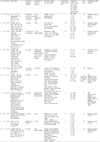1. World Health Organization. Revised 1990 estimates of maternal mortality: a new approach by WHO and UNICEF. 1996. Geneva: World Health Organization.
2. Berg CJ, Chang J, Callaghan WM, Whitehead SJ. Pregnancy-related mortality in the United States, 1991-1997. Obstet Gynecol. 2003. 101:289–296.

3. New estimates of maternal mortality. Wkly Epidemiol Rec. 1996. 71:97–100.
5. American College of Obstetricians and Gynecologists. ACOG educational bulletin. Postpartum hemorrhage. Number 243, January 1998 (replaces No. 143, July 1990). American College of Obstetricians and Gynecologists. Int J Gynaecol Obstet. 1998. 61:79–86.
6. Cunningham FG, Leveno KJ, Bloom SL, Hauth JC, Gilstrap L, Wenstrom KD. Williams Obstetrics. 2005. 22nd ed. New York: McGraw-Hill Professional.
7. Macphail C, Fitzgerald J. Massive post-partum haemorrhage. Curr Opin Obstet Gynecol. 2001. 11:108–114.

8. Katesmark M, Brown R, Raju KS. Successful use of a Sengstaken-Blakemore tube to control massive postpartum haemorrhage. Br J Obstet Gynaecol. 1994. 101:259–260.

10. Schnarwyler B, Passweg D, von Castelberg B. Successful treatment of drug refractory uterine atony by fundus compression sutures. Gerbultshilfe Frauenheilkd. 1996. 56:151–153.
11. B-Lynch C, Coker A, Lawal AH, Abu J, Cowen MJ. The B-Lynch surgical technique for the control of massive postpartum haemorrhage: an alternative to hysterectomy? Five cases reported. Br J Obstet Gynaecol. 1997. 104:372–375.

12. Hayman RG, Arulkumaran S, Steer PJ. Uterine compression sutures: surgical management of postpartum hemorrhage. Obstet Gynecol. 2002. 99:502–506.

13. Park RC, Duff WP. Role of cesarean hysterectomy in modern obstetric practice. Clin Obstet Gynecol. 1980. 23:601–620.

14. Cosgriff N, Moore EE, Sauaia A, Kenny-Moynihan M, Burch JM, Galloway B. Predicting life-threatening coagulopathy in the massively transfused trauma patient: hypothermia and acidoses revisited. J Trauma. 1997. 42:857–861.
15. Hardy JF, De Moerloose P, Samama M. Groupe d'intérêt en Hémostase Périopératoire. Massive transfusion and coagulopathy: pathophysiology and implications for clinical management. Can J Anaesth. 2004. 51:293–310.

16. Hardy JF, de Moerloose P, Samama CM. The coagulopathy of massive transfusion. Vox Sang. 2005. 89:123–127.

17. Hirshberg A, Dugas M, Banez EI, Scott BG, Wall MJ Jr, Mattox KL. Minimizing dilutional coagulopathy in exsanguinating hemorrhage: a computer simulation. J Trauma. 2003. 54:454–463.

18. Armand R, Hess JR. Treating coagulopathy in trauma patients. Transfus Med Rev. 2003. 17:223–231.

19. Leslie SD, Toy PT. Laboratory hemostatic abnormalities in massively transfused patients given red blood cells and crystalloid. Am J Clin Pathol. 1991. 96:770–773.

20. Reiss RF. Hemostatic defects in massive transfusion: rapid diagnosis and management. Am J Crit Care. 2000. 9:158–165.

21. Slichter SJ. Identification & management of defects in platelet hemostasis in massively transfused patients. Prog Clin Biol Res. 1982. 108:225–258.
22. Practice Guidelines for blood component therapy: a report by the American Society of Anesthesiologists Task Force on Blood Component Therapy. Anesthesiology. 1996. 84:732–747.
23. Samama CM, Djoudi R, Lecompte T, Nathan-Denizot N, Schved JF. Agence Française de Sécurité Sanitaire des Produits de Santé expert group. Perioperative platelet transfusion: recommendations of the Agence Française de Sécurité Sanitaire des Produits de Santé (AFSSaPS) 2003. Can J Anaesth. 2005. 52:30–37.

24. Vaslef SN, Knudsen NW, Neligan PJ, Sebastian MW. Massive transfusion exceeding 50 units of blood products in trauma patients. J Trauma. 2002. 53:291–295.

25. Malone DL, Hess JR, Fingerhut A. Massive transfusion practices around the globe and a suggestion for a common massive transfusion protocol. J Trauma. 2006. 60:S91–S96.

26. Yamashita Y, Harada M, Yamamoto H, Miyazaki T, Takahashi M, Miyazaki K, et al. Transcatheter arterial embolization of obstetric and gynaecological bleeding: efficacy and clinical outcome. Br J Radiol. 1994. 67:530–534.

27. Lédée N, Ville Y, Musset D, Mercier F, Frydman R, Fernandez H. Management in intractable obstetric haemorrhage: an audit study on 61 cases. Eur J Obstet Gynecol Reprod Biol. 2001. 94:189–196.

28. Kirsop R, Jakubowicz D. Management of haemorrhage in a case of acute fatty liver of pregnancy by internal iliac artery embolisation. Br J Obstet Gynaecol. 1992. 99:1014–1016.

31. Collins CD, Jackson JE. Pelvic arterial embolization following hysterectomy and bilateral internal iliac artery ligation for intractable primary post partum haemorrhage. Clin Radiol. 1995. 50:710–713.

32. Oei PL, Chua S, Tan L, Ratnam SS, Arulkumaran S. Arterial embolization for bleeding following hysterectomy for intractable postpartum hemorrhage. Int J Gynaecol Obstet. 1998. 62:83–86.

33. Plauché WC, Gruich FG, Bourgeois MO. Hysterectomy at the time of cesarean section: analysis of 108 cases. Obstet Gynecol. 1981. 58:459–464.
34. Noris M, Remuzzi G. Uremic bleeding: closing the circle after 30 years of controversies? Blood. 1999. 94:2569–2574.






 PDF
PDF ePub
ePub Citation
Citation Print
Print




 XML Download
XML Download